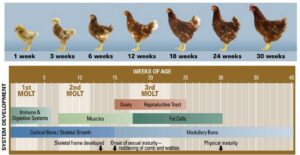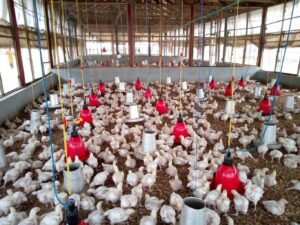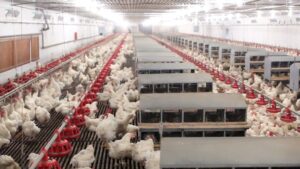Thank you for reading. Don't forget to subscribe & share!
Feed additives are substances added to poultry diets in small quantities to improve feed quality, enhance nutrient utilization, promote growth, and maintain bird health. These additives serve various purposes and can include nutritional supplements, antimicrobials, enzymes, antioxidants, and more. Here are some common types of feed additives used in poultry diets:
1. Nutritional Supplements:
Vitamins: Vitamin supplements are added to poultry feed to meet specific vitamin requirements, ensuring optimal health, growth, and reproduction.
Minerals: Mineral supplements provide essential minerals like calcium, phosphorus, potassium, magnesium, and trace minerals, maintaining bone health, electrolyte balance, and overall metabolism.
Amino Acids: Synthetic amino acids such as lysine, methionine, and threonine may be added to balance the amino acid profile of feed, optimizing protein utilization and growth.
2. Antimicrobials:
Antibiotics: Historically used as growth promoters and to prevent or treat bacterial infections. However, due to concerns about antimicrobial resistance, their use is increasingly restricted or prohibited in many regions.
Anticoccidials: Substances used to control coccidiosis, a common intestinal disease in poultry caused by protozoan parasites.
3. Enzymes:
Phytase: Enhances the digestibility of phytate-bound phosphorus in plant-based feed ingredients, improving phosphorus utilization and reducing phosphorus excretion.
Protease, Amylase, Lipase: Breaks down proteins, carbohydrates, and fats, improving nutrient digestibility and feed efficiency, especially in diets containing high levels of plant-based ingredients.
4. Acidifiers:
Organic Acids: Include compounds like formic acid, acetic acid, citric acid, and their salts. They lower the pH of the digestive tract, creating an unfavorable environment for pathogens and improving nutrient digestion and absorption.
Buffers: Substances like sodium bicarbonate or potassium carbonate are added to neutralize excess acidity in the digestive tract, preventing digestive disturbances.
5. Probiotics and Prebiotics:
Probiotics: Live microorganisms (e.g., beneficial bacteria) that promote gut health and balance the intestinal microbiota, enhancing nutrient absorption, immune function, and overall health.
Prebiotics: Non-digestible dietary fibers that stimulate the growth and activity of beneficial gut bacteria, supporting digestive health and immune function.
6. Antioxidants:
Vitamin E, Vitamin C, Selenium: Antioxidant vitamins and minerals protect cells from oxidative damage caused by free radicals, supporting immune function and reducing stress-related health issues.
7. Mycotoxin Binders:
Adsorbents: Substances like activated charcoal, bentonite clay, and hydrated sodium calcium aluminosilicate (HSCAS) bind mycotoxins in the digestive tract, preventing their absorption and reducing the adverse effects of mycotoxin contamination in feed.
8. Pigments:
Carotenoids: Natural or synthetic pigments added to poultry feed to enhance egg yolk color and skin pigmentation in broilers and breeders.
9. Flavor Enhancers:
Palatants: Natural or synthetic compounds added to improve feed intake and palatability, especially in diets containing unappetizing or bitter-tasting ingredients.
10. Growth Promoters (Alternative to Antibiotics):
Probiotics, Prebiotics, Organic Acids: Some feed additives may indirectly promote growth by improving gut health, nutrient absorption, and feed efficiency without the use of antibiotics.
In Summary the use of feed additives in poultry diets should be based on sound nutritional principles, scientific evidence, and regulatory guidelines. Proper dosage, mixing, and monitoring are essential to ensure the safety, effectiveness, and regulatory compliance of feed additives in poultry production.
A variety of different feed additives are commonly used in poultry diets or can be used when the need arises.
Antioxidants
Fat is often added to poultry diets to increase the energy content, this is especially the case in high density broiler diets. In addition, if fish meal is used, it is high in fat. To help keep feed from going bad, which is common in high fat products, antioxidants are commonly added to the diet. Compounds with antioxidant properties include ethoxyquin, butylhydroxytoluene (BHT), butylhydroxyanisole (BHA), vitamin C, and vitamin E.
Free-flowing agents
It is important that the feed flow easily so that it does not cake in the feeders. Free-flowing agents are substances added to the diet to make sure the feeds do not pack down. Free-flowing agents typically have fine particulate structures while not reacting to the other ingredients in the feed. A common free-flowing agent is hydrated sodium aluminosilicate.
Pelleting additives
Pelleting of feeds has been shown to improve feed efficiency for some poultry species. Most broiler feeds are pelleted. It is important to make sure that the feed ingredients can be packed together in bite-sized pellets without a lot of fines. A variety of pelleting additives are available.
Feeding enzymes
Many of feed ingredients available for use in poultry diets have anti-nutritional factors which limit their use. Feed enzymes have been developed that break down these anti-nutritional factors increasing the potential of many ‘alternative grains’. The use of feed enzymes is quite common in Europe where wheat and barley are often used instead of corn.
Mold inhibitors or mycotoxin binders
Cereals are subject to mold growth, which can happen in the field, during post-harvest handling, storage and processing. Even if the mold is removed, the mycotoxins they produce will remain and can be very toxic to poultry. Many feeds contain a mold inhibitor or a mycotoxin binder to prevent the mycotoxins from being absorbed trough the gut and into the blood stream. Common mycotoxin binders are Mycosorb, Mycofix, ProSid, Mycoad—which appears on the Organic Materials Review Institute (OMRI) list—and Toxisorb.
Coccidiostats
Coccidiosis is a problem in many species of poultry raised on the floor. The protozoa that cause coccidiosis are found everywhere. A low level of coccidia in the digestive tract is not a problem, but high levels can result in poor feed efficiency, poor health and ultimately death. Coccidiostats are sometimes added to feed to keep the coccidia at low levels, especially early in bird growth, to allow them to develop resistance. They do not treat the condition, but help in preventing it. Common coccidostats include amprolium (Aprol, Corid), decoquinate (Deccox), diclazuril (Clinacox), halofuginone (Stenorol), lasalocid sodium (Avatec, Bovatec), monensin (Coban), robenidine (Robenz), and salinomycin (Bio-Cox, Sacox).
Antibiotics
The digestive tract of all animals contain a diverse population of microbes. Some are classified as ‘good’ and are necessary for maintaining gut health. There are also ‘bad’ bacteria which, when present at high levels can adversely affect gut health, and can ultimately result in damage to the intestines. This is referred to as necrotic enteritis.. Low-level, or sub-therapeutic levels, of antibiotics can be added to feed to keep the ‘bad’ bacteria in check. Bacitracin is a commonly added antibiotic.
If a disease situation it may be necessary to add therapeutic levels of antibiotics to the feed, although for most treatments the antibiotics are added in the feed. A sick bird with typically drink but may not eat. By adding the antibiotics in the water you assure that the birds are being sufficiently treated.
Antibiotic alternatives
The desire to reduce use of antibiotics in animal production, alternatives have been developed. The best way to keep the ‘good’ bacteria at higher levels than the ‘bad’ is to add the nutrients which promote the growth of the good. These are referred to as probiotics, since they encourage the growth of some bacteria. Providing nutrients, such as mannan oligosaccharides (MOS), that promote good bacteria will help to maintain gut health. There are a number of MOS products available, including Bio-MOS, Celmanax, Nupro, and SAF-Mannan.









